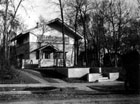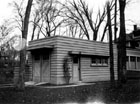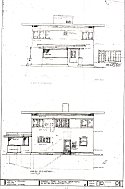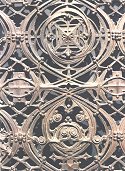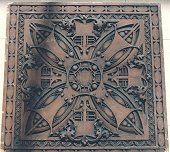 |
firm active: 1907-1921 minneapolis, minnesota :: chicago, illinois |
Ye Olde Grindstone
2/14/2003
Charles Wiethoff residence
Minneapolis, Minnesota
Wiethoff Garage
Sweet, ain't it?Happy Valentine's Day. A kiss of welcome to the first images here of the Charles Wiethoff residence, one of the many P&E houses that cluster around the "lakes" in Minneapolis. To those living there, the "lakes" pretty much include the stretch of four bodies of water along the southern suburban underbelly of Minneapolis--northernmost Lake Cedar (connected to Lake of the Isles by canal, but bereft of any P&E, Lake Cedar was wild and inaccessible in the 1910s and not really developed to any great degree until after World War II), Lake of the Isles (the closest to the Hennepin Avenue trolley line downtown, populated in the 1910s with university professors, architects (!), doctors, dentists, lawyers, and the second generation children of what passed for Old, mostly Presbyterian, Money), just a canoe paddle away to Lake Calhoun (where some of the best UNBUILT P&E was intended to go) and lastly the detached (you have to walk) old time duck-hunting zone of southernmost Lake Harriet. The Wiethoffs built late in the game, 1917. Their lot was further south than many of the P&E houses, but within a block of Lake Harriet. Nice, if limited, view.
A small, box-like plan, the house had a modest budget and decorative development was limited mostly to some light fixtures and a few leaded glass panels. Unfortunately, this residence suffered grievously over the years, and from one owner in particular who had an office on France Avenue in Edina with a shingle saying "architect." One of my friends is a realtor in Minneapolis and, when the Wiethoff house came on the market, he kindly got me in the door one overcast afternoon. The dining room doors were missing by this point, though the spackle was still soft to the touch.
2/11/2003
Added all the Parabiographies entries for 1916, 1917, and 1919, little though they are. Still hacking away at 1914.
2/9/2003
Open Air Theater
Anoka, Minnesota 1915Ah, a Sunday. One of the small perks of living in this part of Los Angeles is having friends who are Academy or Guild members. While the studios still arrange private, invitation only screenings at theaters (which are ALWAYS booked full in short order so you can never get in), nowadays DVDs are mailed out by studios and production companies seeking awards nominations. Being appalled by the "company" of the public audience (the rustling of food, the ceaseless shrill cell phones, the endless jabbering), new movies have not been on my list of things to do for a long while. Recently, however, I have been spending Sunday nights at a friend's house watching these "For Your Consideration" DVDs of Chicago, The Pianist, Catch Me If You Can, Antwone Fisher, and so forth [I turned down both Gangs of New York and Road to Perdition; TOO dark, as if The Pianist wasn't!]. How nice to know someone in the local aristocracy. Tonight's offering was Adaptation, but I felt worn out so I stayed home. Meryl Streep just wasn't enough to get me out the door. Sorry, Meryl. Then, slow-witted as I can be, I remembered that Sunday nights used to be one of my most productive on P&E. So, here we are.
Continued the process of putting up Parabiographies entries for 1914 and 1915 [1915, COMPLETED!]. Probably the best read is the one for the Woodbury County Court House, where Purcell talks about being with Gutzon Borglum and H. P. Berlage during the latter's tour of America in 1912. Also of interest is the briefer description of the Open Air Theater, built in Anoka, Minnesota for Thaddeus P. Giddings. Giddings was Purcell's teacher in the Oak Park schools, and remained a lifelong friend. The account of "solving" the mystery of the canvas coverings for the Roman Coliseum is verified, since we are on a Hollywood note tonight, in the CGI done for Gladiator. Well worth a freeze frame or two if you have the DVD. Built the basic page structures for The Western Architect issues, which will be a challenge to get up. My scanner won't support page sizes that large, and I am loathe to stress out my original copies anyway. What to do?
2/8/2003
Spent a long week in high pressure deadlines, but made them. Finally get a moment for my own work. Created or altered 27 pages tonight in 2-1/2 hours; this pokey FrontPage is a drag! I could do twice as much if the links didn't take 45 seconds or more to form. Tonight I added a non-sequential miscellany of Parabiographies entries for 1914 and 1915. The most interesting were the texts discussing the winning Federal Parliament Competition design by Walter Burley Griffin and a very surprising reason some P&E clients named Simons--who were very satisfied with their proposed residence and could well afford to build--in the end decided not to proceed. Finally, there is the discovery of the new in things long familiar. Putting up the Parabiographies has caused me to read them again, and I have been taking the time to make interstitial links between the jobs as they are referenced in the drafts. The most amazing collection of related references shows the evolution of the design that finally took constructed form as the Edna S. Purcell summer residence in Moylan-Rose Valley, Pennsylvania. (And no, I can't account for the spurious ">" in the previous sentence that appears in some browsers. The HTML is correct. It's probably FrontPage being spiteful about my complaint)
2/1/2003
Working drawing
Thomas Snelling residence
Waukegan, Illinois
Teller's wicket
National Farmers' Bank
Owatonna, Minnesota
Detail, grille
Schlesinger & Mayer Store
Chicago, Illinois
Terracotta panel
George Grant Elmslie
1905Welcome to another month--they haven't disconnected the DSL yet! Mounted the working drawings for the Snelling residence, one of those wonderfully direct (read: economically efficient) "cube" houses like the Backus house (and the near carbon copy Fred Babson farmhouse, whose distinction seems to be in minor exterior details). While not directly documentation of P&E work, I have also added some Elmslie-designed metalwork: one of the few surviving teller's wickets from the National Farmers' Bank in Owatonna and a cold air return grille found just inside that wonderful corner entrance to what is now Carson Pirie Scott in Chicago; and a piece of terra-cotta that is, I think, my favorite Elmslie mandala. Dated 1905, this fragment hangs in the architectural graveyard on the second floor of the entry atrium at the Chicago Institute of Art. Since taking this image in the late 1980s, I've lost the notepad with the building attribution. Any wise souls out there know the name?
